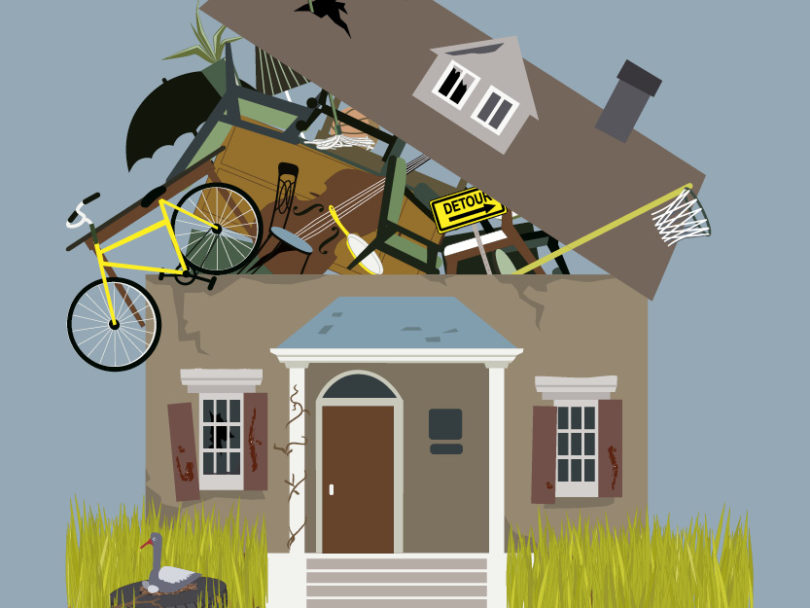Clinical Definition of Hoarding:
The acquisition of and failure to discard a large number of possessions that appear to be useless or of limited value. Living spaces sufficiently cluttered as to preclude activities for which these spaces were designed.
We gasp with horror when television shows cover stories of extreme hoarding—houses so full that the resident has to sleep outside or crawl across the mass of debris stacked to the ceiling. Of course, we would never let our house get like that! But then again. News Flash! A big truck didn’t pull up to any of these folks’ houses while they slept and filled them up with “stuff.” Clearly, these houses didn’t get that way overnight. Maybe there were warning signs along the way, signs that can help you avoid becoming a hoarder, such as the following:
- What about that growing stack of newspapers? You haven’t had a chance to sit down and read them all the way through. The news is days (or weeks?) old but there might be some important piece of information that you really need to know. Just recycle them! The past is past. If it is something really important, you’ll have heard about it or can get it somewhere else. And the magazines waiting to be read—medical offices, women’s shelters, other places that would be happy to receive them. You will find that most periodicals tend to repeat the themes fairly regularly (e.g., the 10-minute meals, organizing your clutter, etc.), so you really won’t miss too much if you don’t read them cover to cover.
- The junk mail just keeps coming. Have you ever missed paying a bill or renewing an insurance policy because it was buried under a mountain of advertising flyers? A good rule of thumb is to stand over the recycle bin when you bring in the mail—discard the junk then and there. (Remember the acronym OHIO—Only Handle It Once.)
- You’ve tried and tried to lose those pesky five or ten pounds; and this year, for sure, it’s gonna happen. Then you can wear that favorite skirt again. That’s why it’s still hanging there all forlorn in the closet. Give it (and all the others that don’t fit) to the thrift store so someone else can enjoy it. And when you meet that weight goal, reward yourself with new favorites.
- “When I get time, I’m going to sort and file all those old photos, all those recipes, all those whatevers…” The piles of unfinished projects, those reminders of failed good intentions, can spoil a good day. The recipes—no doubt torn from the newspaper or surreptitiously taken from a magazine in the doctor’s waiting room—never tried. Most recipes can be found online, and if it’s Grandma’s special dish to be treasured and prepared over and over, put it in a recipe file where you can actually find it when you want to make it. The photos of unidentified relatives or babies of long ago acquaintances—who are we saving them for? If truly important, photos should be sorted in some simple fashion and can even be scanned into the computer for posterity. Above all, identify the subjects, discard the unknowns.
- “I know that little [fill in the blank] is out in the garage somewhere.” Of course it is—you just don’t know where you stuck it. Now you need it and can’t find it. Guess you’ll have to run down to the hardware store and buy another one, since that takes less time and effort than searching through the garage. It does no good to save something “in case I might need it one day” when it is nowhere to be found on that day. The garage, presumably meant for the car—hahaha—should not be a repository of all the little bits and pieces that we don’t have a proper place for. A few shelves and bins, labeled and organized, can work wonders. Save money and time, also.
What’s Normal?
Most of us are guilty of a little clutter in our lives—it reflects our interests and hobbies, it is a testament to our busy schedules, and it doesn’t affect our health or well-being. Hoarding has been identified as a type of Obsessive-Compulsive Disorder. The hoarder treats all saved items as equally valuable, unable to differentiate between trash and treasure, whether or not the items have sentimental, financial, or functional value. Their homes may present fire and trip hazards from blocked hallways and piles of paper, or threaten health from dust, insect and rodent infestation, or animal waste. Their usable living space is reduced by all the saved items. They are embarrassed and ashamed of their situation, but feel powerless and too overwhelmed to resolve it. The hoarding interferes with their daily lives in a number of ways. True hoarders become socially isolated because they’re too ashamed to let anyone in.
If you know someone who truly fits this picture, there is help available through therapy for OCD as well as from professional organizers. Psychologist Randy Frost of Smith College has written numerous articles and books on the subject, offering insight and help. Television has offered documentaries (for example Hoarding: Buried Alive) as well
as “reality” shows exposing extreme cases.
For the rest of us, we just need to be realistic as to how many gadgets, garden gnomes, magazine subscriptions, or other things we really need.

